Anabantids
Gouramis
By far and away the most popular group of fishes among the anabantids are the gouramis belonging to the family Belontiidae. Of these, members of the genus Trichogaster, such as Trichopterus sumatranus (Blue gourami), Trichopterus microlepis (Moonlight gourami), and Trichopterus leeri (Pearl gourami), are probably the easiest fishes to keep because they are tolerant of most water conditions. They are medium-sized fishes (10-15 cm/4-6 in) and are well suited to a community aquarium as long as their companions are not too small. Occasionally, however, large adults will bully other fishes and may have to be moved to an aquarium in which they are the smallest fishes. The only other problem which may occur is the gouramis having their ventral fins nipped by their tankmates.
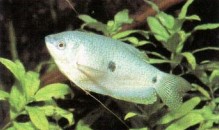
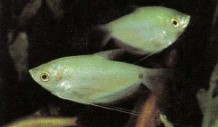
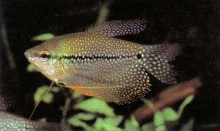
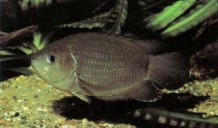
When purchasing them from an aquarium shop, try to buy them in pairs. Some species are virtually impossible to sex as juveniles, but as adults it should be obvious. The easiest way to sex them is to look at the dorsal fin; in males this is slightly longer than in females and may culminate in a point. In Trichogaster leeri (pearl gourami) males, not only is the dorsal fin longer and pointed, but the anal fin has extensions to the fin rays, and the throat is a beautiful blood red when the fish is in good condition.
The larger gouramis do not need any special conditions, although they do prefer the water to be on the warm side. Anywhere between 25-28°C (77- 82°F) seems to suit them. The aquarium should be heavily planted towards the back and sides, and a few caves can be created out of rocks or bogwood.
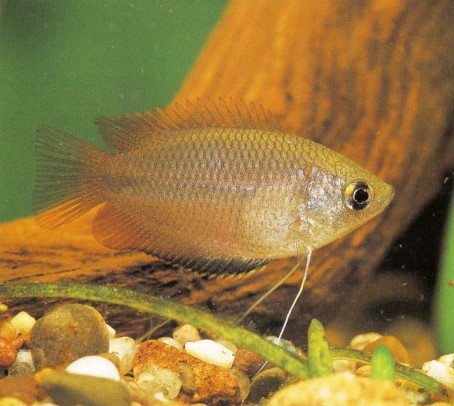
Colisa lalia (Dwarf gourami), is another very popular gourami. They are ideal for the smaller community aquarium since they grow to a maximum of about 5 cm (2 in). They are normally sold only in pairs, mainly because the female is an uninteresting silvery colour with pale vertical bars, whereas the male’s bars are a brilliant red alternating with blue. The temptation for the novice aquarist is to purchase the highly coloured fish: Indeed, he or she may not even realize that the silvery creature is the female.
Other members of the genus Colisa are also suited to the smaller aquarium. The one you are most likely to come across is Colisa sola (Honey gourami). Again females are rather drab, being a pale brown on the back and silver on the belly with a dark stripe running from the eye to the caudal peduncle. Males exhibit a similar coloration when they feel insecure, which they do in a shop tank, but once settled in your aquarium they will soon show their full colour. This consists of a lemon yellow dorsal fin and dark blue-black head, throat, and front portion of the anal fin. The rest of the body and fins is a lovely copper colour. These fishes are delicate, so be patient, and wait until you have more experience and your aquarium is mature before you try to keep them.
We suggest you try Trichogaster trichopterus (Three spot gourami or Blue gourami), Trichogaster leeri (Pearl gourami), Trichogaster microlepis (Moonlight gourami), Trichogaster pectoralis (Snakeskin gourami), Colisa lalia (Dwarf gourami), Colisa fasciata (Giant gourami), and Colisa labiosa (Thick-lipped gourami).
Breeding Gouramis
To breed these bubblenest builders, you will need an aquarium at least 100 cm (36 in) long for the larger species and 60 cm (24 in) for the smaller ones. Provide some thickets of plants which reach to the surface, and use only minimal filtration to create a very gentle water movement. The plants have a dual purpose: firstly they provide shelter for the female when the male becomes a little too pushy, and secondly, some species add plant matter to the bubblenest to help bind the bubbles together. It is also important to have a tightfitting cover glass over the aquarium so that the air space just above the water surface is warm and humid at all times.
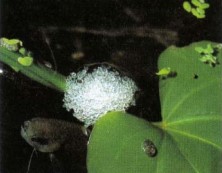
The distance between the water and the cover glass should be about 5-10 cm (2-4 in).
Condition the prospective parents well on live or frozen foods. When they are ready to breed, the male will show interest in the female, seeming to be stimulated by the more rounded appearance of her belly. At this time, he will pick a quiet area of the aquarium, usually in a corner or very close to a clump of plants, and start to build a bubblenest, taking air into his mouth from the water surface and expelling it through his gills. The mucuscovered bubbles float upwards and are kept in a small area by the floating plant leaves. If there is a strong current in the aquarium, the delicate nest will be swept away.
Every so often the male will break off from building his bubblenest and court the female. This will usually take the form of much fin-spreading and wagging his body to and fro. This shows what a splendid male he is and helps excite the female. By the time the nest is complete she will be so worked up that she will spawn straight away. If she is not ready to spawn, however, they will fight, and the male may tear her fins. In this case you will have to move her out of the Colisa sola (honey gourami; is easy to keep in a quiet community aquarium, or a species aquarium if you wish to breed them. Condition them on small live and frozen foods and, when ready, they will build a bubblenest. breeding set up and try again with another female, or return the original one a week later when she may have reached spawning condition.
Once spawning is under way you are in for a real treat. The pair embrace, with the male wrapping himself around the female and then turning her over on to her back as the eggs and milt are expelled. The eggs are lighter than water and float up to the surface. Once the male has recovered from the embrace he collects the eggs together towards the centre of the nest and carefully encases each one in a bubble of mucus-coated air. When the female has recovered from the embrace she helps collect the eggs. Once this task is complete the pair embrace again. During spawning up to 1000 eggs may be laid by the larger gouramis, but a more average spawning will contain about 250 eggs.
When spawning is complete, the male chases the female away and sets about tidying up the nest. First of all he searches round for any missed eggs and places them in the nest, then he blows more bubbles and builds up the nest even more. Once satisfied all is well, he settles down to wait for the fry to hatch. This takes about 48 hours after which the fry can be seen with their tails hanging down rfrom the nest. The male now has his work cut out making sure that any which fall out of the nest are caught up and pushed back in.
On the fifth day the fry become free-swimming and capable of looking after themselves. Soon afterwards the male starts to think of them as food rather than family, eating any he finds. Obviously he must be removed before this happens.
The fry of the larger species are easy to raise so long as you have a good supply of small live foods. Infusoria are necessary as a first food, and can be cultured in a separate container using banana skins or other vegetable matter. Alternatively use commercially produced liquid fry food which can be fed directly to the fry and will also create an infusorial bloom in the aquarium. These foods are needed only for the first week, after which they can be phased out and newly hatched brine shrimp used instead. A wide variety of small live foods, such as micro-worm and sifted Daphnia, need to be included in the diet to produce good, healthy youngsters. Fine-powdered fry food can be fed as a supplement but if fed to the exclusion of live foods will produce poorer results. The fry will grow fairly swiftly and, as broods can be large, ensure you have enough space to grow them on.
Colisa lalia (Dwarf gourami) spawn in a similar manner to the larger species, but the courtship and nest of Colisa sola (Honey gourami) are slightly different. Whereas the other species use quite a lot of vegetable matter in the nest, honey gouramis tend to use little or none at all. The nest is also much more untidy, but the eggs are kept in a single very tight clump right at the centre of the construction. Courtship is also a little different, with the male standing on his tail, so to speak, with his nose pointing towards the surface. His colours are heightened even more at this time, and he spreads all his fins to their utmost and wags his body to and fro.
In these small species the fry are also smaller, looking like little slivers of glass when they first hatch. Really small fry foods are needed and regular, small feeds throughout the day are better than one or two large meals. Be sure to keep the aquarium clean when feeding heavily, as uneaten food will cause a deterioration in water quality.
A word of warning: one of us, when breeding Trichogaster trichopterus (Three spot or blue gourami) for the first time, used an aquarium with very gentle undergravel filtration. Everything was fine while the eggs and fry were in the bubblenest, and even for the first few days when they were free swimming there did not seem to be anything amiss. Then, one morning, a glance into the aquarium revealed a lot of fry trapped in the gravel. They had been resting on the bottom and, even with what appeared to be a very gentle water flow, had been sucked into the substrate with disastrous results – their spines had been damaged. The best part of the brood was lost and a hard lesson was learned. For future spawnings an air-operated sponge filter was used and proved extremely successful. Not only did it filter the tank, but the young fishes were often to be found pecking away at the microorganisms on the sponge.

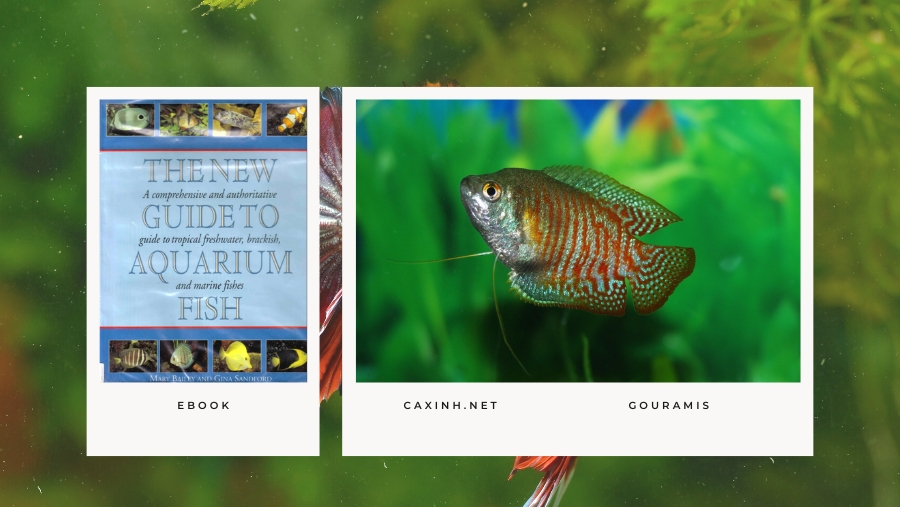

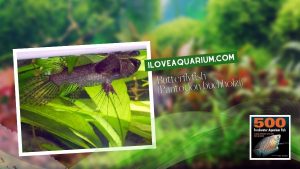
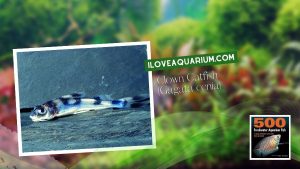
![[Ebook] The New Guide to Aquarium Fish - Characins - Splash Tetras](https://vn1.vdrive.vn/iloveaquarium.com/2023/01/Ebook-The-New-Guide-to-Aquarium-Fish-Characins-Splash-Tetras-THUMB-300x169.jpg)